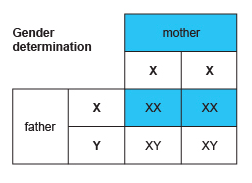Genotype Phenotype
Sex Determination
There is a 50% chance of obtaining a female from contraception, and there is a 50% chance of obtaining a male. The female gamete __would contain __‘X’ chromosome, and the male gamete would contain either the ‘Y’ or ‘X’ chromosome.
The following diagram suggests that there is an equal chance of obtaining a male or a female. Females have a genotype of XX, and males have a genotype of XY__. __
Blood Groups
An individual has two copies of each gene, so can only have two alleles of any gene, but there can be more than two alleles of a gene in a population - this is called multiple alleles. This can be found when studying human blood groups.
- The red blood cell antigen is coded for by the gene I, which has three alleles IA, IB and IO.
- IA and IB are not dominant over one another
- both are dominant over IO
Here are the possible genotypes (alleles present) and phenotypes (blood group):
Causes of Variation
Here are the two main causes of variation that influence the phenotype:
- Genetic variation__ __(where different characteristics are obtained due to mutation and sexual reproduction).
- Environmental variation__ __(Where different characteristics are caused by an organism’s environment. These characteristics tend to be acquired from their surroundings. E.g. if a person decides to dye their hair, get a tattoo, get a piercing).
Human Genome Project
The Human Genome Project started in 1990 and was completed in 2003. They investigated all of the base pairs that made up the genome of individuals. It has been extremely useful for scientists are can now look at a range of diseases and whether their genetics is linked to them.
Advantages:
- Predict and prevent diseases - knowing which genes are involved with particular conditions. Doctors can then predict which people are likely to suffer from a particular disease
- Improved and personalised medication based on the way our individual bodies react to the disease and the treatments
- Doctors can develop more accurate diagnostic techniques for certain conditions which are difficult to diagnose at an early stage.
- Genetic fingerprinting helps to match a suspect to the biological material found at a crime scene. In the future it could be possible to figure out what a suspect looks like from DNA found at a crime scene e.g. their eye, hair and skin colour.
- Begin preventative work if a person is likely to obtain a specific disease.
Disadvantages:
- People who are diagnosed with an illnesses may be more susceptible about their future
- People with genetic problems could be under pressure not to have children as a threat of passing on their faulty genes onto the next generation.
- Discrimination by employers and insurers: Life insurance could be impossible to get and more expensive if you have any genetic likelihood of serious disease. Furthermore, employers may discriminate against people who are genetically likely to get a disease and be favourable to those who are healthy.
Evaluation:
- The Human Genome Project is beneficial for science and preventing disease and curing diseases. However, it raises ethical issues as it can cause discrimination by employers and insurers.
Mutation
A mutation is a change in the gene or chromosome.
Although it is quite rare, it is still possible and can have life-changing effects on an individual. A mutation is something that can be inherited from the parents.
A lot of variation arises within the population because of mutation that has taken place.
Causes of mutation:
- Spontaneous - not something that we can control
- Ionising radiation - e.g. gamma rays, x-rays, UV rays
- Chemical mutagens - (e.g. from tar that can be found in cigarette smoke)
Some mutations can have little to no effect, some can be useful, but some are also harmful. It depends on where the mutation took place, and whether it is severe or not.
For those individuals with Down’s syndrome, they have three copies of chromosome 21 (normally there is only two copies). This is when an extra gamete is formed during meiosis - therefore it has create an extra copy of chromosome 21. This means that the individual will now have Down’s syndrome.
- What are the two main causes of variation?
- Your answer should include: Genetics / environment
- Name three possible causes of mutation.
- Your answer should include: Spontaneous / ionising radiation / chemical mutagens
- What is the gender of someone that has the genotype of XX?
- female

